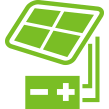Geothermal Paired with Solar
Electricity Generation and Savings
Pairing a solar photovoltaic (PV) system with a ground source heat pump (GSHP) creates a highly efficient and sustainable energy solution. A solar PV system generates clean electricity from sunlight, and a GSHP uses that electricity to move heat into or out of a building, taking advantage of the earth’s stable underground temperature. The major benefit of this pairing is synergy, where each system enhances the other’s performance. The electricity produced by the solar panels can directly power the heat pump’s compressor and pumps, offsetting the heat pump’s electricity consumption and reducing or even eliminating a home’s dependence on the electrical grid. This is particularly effective during the summer months when solar panels produce the most electricity and the GSHP is running to provide cooling. This combination significantly lowers energy bills and a building’s overall carbon footprint, moving it closer to a net-zero energy status.





The 4-Step Process of Solar + Geothermal

Step 1: Insulation
A tight thermal envelope ensures the highest quality performance, comfort, and R-value for home and building owners.

Step 2: Install a Geothermal System
Proper insulation allows for a smaller geothermal system, which results in lower installation costs.

Step 3: Install a Solar Array

Step 4: Get Batteries
Combining geothermal and solar is the best way to get your home or building closer to net-zero or go off grid. Download the infographic with full details and get started toward the lowest possible bills today!